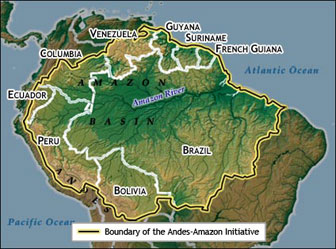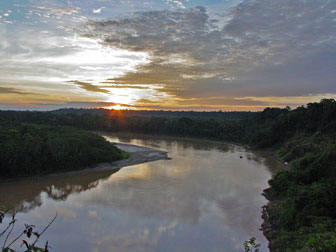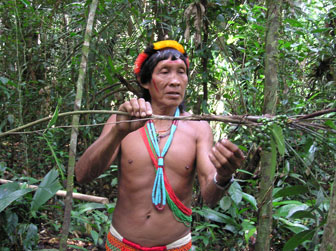Who pays for Amazon rainforest conservation?
Who pays for Amazon rainforest conservation?
An interview with the largest private sponsor of rainforest protection: the Gordon and Betty Moore Foundation
Rhett Butler, mongabay.com
December 11, 2006
Monday, Brazil created the world’s largest rainforest protected area in the northern Amazon. Covering more than 15 million hectares (57,915 square miles) — or an area larger than England — the network of seven new protected reserves has been met with praise by environmental groups. Instrumental in the development of the conservation project has been an organization that most people wouldn’t associate with rainforest conservation but certainly should: the Gordon and Betty Moore Foundation.
Established by Gordon Moore, founder of Intel, and his wife, the Gordon and Betty Moore Foundation is today the largest private donor to Amazon conservation and research, doling out more than $200 million to projects in the region since 2001 (more than $358 million if you include the neighboring Andes region). The sum may represent a quarter of all money spent in the Amazon basin by non-governmental groups, according to a November 19th article in San Francisco Chronicle Magazine.
The Foundation says its primary objective is to achieve “the effective management of 370 million hectares of forested landscapes” which it says are needed to maintain the climatologic function of the Amazon Basin and protect the region’s biodiversity distributed across eight major ecoregions and 13 major watersheds in order to preserve the region’s long-term ecological viability. The 370 million hectares represents 45 percent of the region’s 815 million hectares of rainforest and is considered a threshold below which the Amazon rainforest ecosystem may tip towards a radically different landscape dominated by dry savanna. The shift would have a dramatic impact on the region’s plant and animal life.
 Gordon and Betty Moore Foundation’s Andes-Amazon Initiative |
To avoid this fate, the Foundation is funding projects in Brazil, Bolivia, Peru, Ecuador, Venezuela and Suriname. Focusing on research rather than land acquisition — a particularly contentious issue in the Amazon where such “land-grabs” are often seen as a threat to national sovereignty — most funds go to conservation groups and scientists working in the area. Much of the headline-grabbing Amazon research in recent years — from climate projections for the Amazon to the role of indigenous populations in reducing deforestation in protected areas — has been funded to some degree by the Moore Foundation. Conservation International, an innovative organization that has combined pioneering biological research with a corporate strategy to pinpoint critical conservation targets, has been the largest recipient of funds, though World Wildlife Fund, the Field Museum, the Wildlife Conservation Society, the Amazon Conservation Association, Woods Hole Research Center, Instituto Internacional de Educação do Brasil, Instituto Socioambiental, and the Amazon Conservation Team have also received sizeable grants since 2001.
The rainforest conservation underwriting process
The Foundation does not accept unsolicited proposals. Instead it relies on a team of researchers and a network of scientific contacts to identify potential grantees which may include NGOs, research institutions, and universities. Like a good financial planner, the Foundation uses a “portfolio strategy” in deciding how to disperse funds and often issues grants in a series “to increase the effectiveness of the overall initiative [and reduce] the risk of failure of any one grant.”
While there have been few failures in the first five years of the initiative, the foundation faces some obstacles, notably from development interests that see conservation inherently opposed to economic development and some environmentalists who feel that more money should be used for park creation rather than science funding. Still, as the largest and most influential sponsor of conservation in the world’s biggest rainforest, some criticism is to be expected.
In December 2006 Dr. Rosa Lemos de Sa, leader of the Gordon and Betty Moore Foundation’s Andes Amazon Initiative, answered some questions from mongabay.com on the foundation’s efforts.
Interview with Rosa Lemos de Sa, Andes-Amazon Initiative lead for the Gordon and Betty Moore Foundation
Mongabay: Why the focus on the specific Andes-Amazon region? Do Gordon and Betty Moore have special interest in rainforests or watersheds?
 Snapshot: Gordon and Betty Moore Foundation’s Andes-Amazon Initiative source: www.moore.org Outcome: Increase the size, quality and durability of the protected area systems of the Amazon Basin. Geography: The Amazon Basin and the adjacent forests of the Guiana Shield, an area spread across nine countries and territories: Brazil, Bolivia, Peru, Ecuador, Colombia, Venezuela, Guyana, Suriname, and French Guiana. The Amazon Basin, as defined by our initiative, consists not only of the Amazon watershed, but also includes the eastern slope of the Andes and the contiguous forest that extends northward from Brazil through the Guiana Shield and upper Orinoco drainage of Venezuela. Together, this area encompasses 815 million hectares (a little more than 2 billion acres) of tropical terrestrial and aquatic environment. Strategies:
|
Lemos de Sa: The Foundation has a strong interest in environmental conservation, and the Andes Amazon Basin is the largest remaining tropical forest. Protecting this important forest has global implications. The greatest plant and animal biodiversity are encountered in this region and the opportunity to protect it is now! The Foundation’s Andes Amazon initiative aims at protecting the hydrological and biodiversity functions of the Basin, as well as local climate. Gordon Moore has visited the region several times and has supported conservation efforts for a number of years.
Mongabay: Since the Gordon and Betty Moore Foundation Andes-Amazon initiative doesn’t accept unsolicited proposals, how do you become aware of new projects? Do you have a network of contacts and organizations or does your staff keep abreast of the latest research appearing in journals and at scientific conferences?
Lemos de Sa: The staff of the Andes Amazon Initiative is very well informed about the situation in the Basin, not only because many are from the region (we have staff from Brazil, Peru, Colombia and Venezuela) and have personal contacts and experience, but also because they travel often to the sites and are exposed to the realities of each region. The network of grantees and partner organizations is another source of information, as well as research and news from the region.
Mongabay: Are grants given solely to organizations or do you fund research by individual scientists?
Lemos de Sa: Grants are given to institutions – NGOs, research institutions, universities — some programs run by these organizations fund scholarships and individual research. Therefore, the Foundation funds individuals only indirectly.
Mongabay: Is the Moore Foundation funding any research into “terra preta”, the soil formation process that enhances crop production in the Amazon while at the same time sequestering carbon? It is created through a farming technique pioneered by pre-Colombian populations and seems to be garnering a lot of interest in academic circles but I haven’t seen a lot of evidence that the technique is being widely implemented. I’ve had several inquiries on it in the past few months.
Lemos de Sa: The Moore Foundation is not funding any research into “terra preta”.
Mongabay: What are the new initiatives under consideration?
|
Organizations that have received Moore funding
Amazon Conservation Association The Amazon Conservation Association, a group that seeks to conserve the biological diversity of the Amazon Basin, is one organization that has received funding from the Moore Foundation. According to its web site, the Amazon Conservation Association “envisions a network of state, community, and private lands managed for conservation and sustainable resource use so that the biological diversity of the southwest Amazon basin is conserved.” Amazon Conservation Team The Amazon Conservation Team is another group that has received funding from the Moore Foundation. The Amazon Conservation Team partners with indigenous people to conserve biodiversity, health, and culture in South American rainforests. |
Lemos de Sa: From time to time we look at new themes, but currently we have no new initiatives to report.
Mongabay: How do you measure success of a project?
Lemos de Sa: At the design phase of a project a series of outcomes/results are defined. These results are then monitored by grantees and Foundation staff. Success of a project depends on delivering the results, as well as measuring their impact on the ground. Results may be local or have regional/national impact depending on the initial design.
Mongabay: Intel recently accounted a wireless Internet capable city in the heart of the Amazon. Was the foundation involved in the effort? Does Intel Corporation participate in foundation conservation efforts?
Lemos de Sa: No, the Foundation was not involved in Intel’s announcement nor does Intel participate in any of the Foundation’s conservation efforts.
Mongabay: What are the greatest obstacles to the work of the foundation?
Lemos de Sa: Conservation is strongly tied to developmental issues, be it infrastructure, agricultural expansion or hydroelectric dams. The greatest challenge is to promote development together with conservation of biodiversity. The two are not incompatible if best practices and land use zoning is implemented at the onset of development. Unfortunately, governments do not plan for 50 or 100 years, but quality of life requires a long term vision. Once you have lost what nature provides you for free, the measures to fix, replace or import it are very expensive. Clean water is the most powerful example. To preserve it is cheap; to treat and transport it is very costly. Therefore, political will is the greatest obstacle to any conservation initiative.
About Rosa Lemos da Sá
Rosa Lemos da Sá is currently the Andes-Amazon Initiative Lead. Formerly she served as the Conservation Director at World Wildlife Fund — Brasil. Lemos da Sá holds a PhD in Wildlife Conservation from the University of Florida, Gainesville, a Masters of Science (MS) in Ecology from the Universidade de Brasília, D.F., Brazil, and a Bachelors of Science (BS) in Wildlife Management from the University of Wisconsin-Stevens Point, WI.

